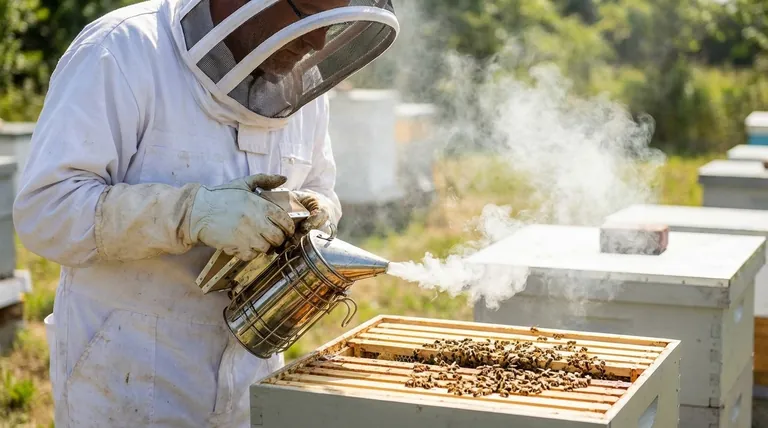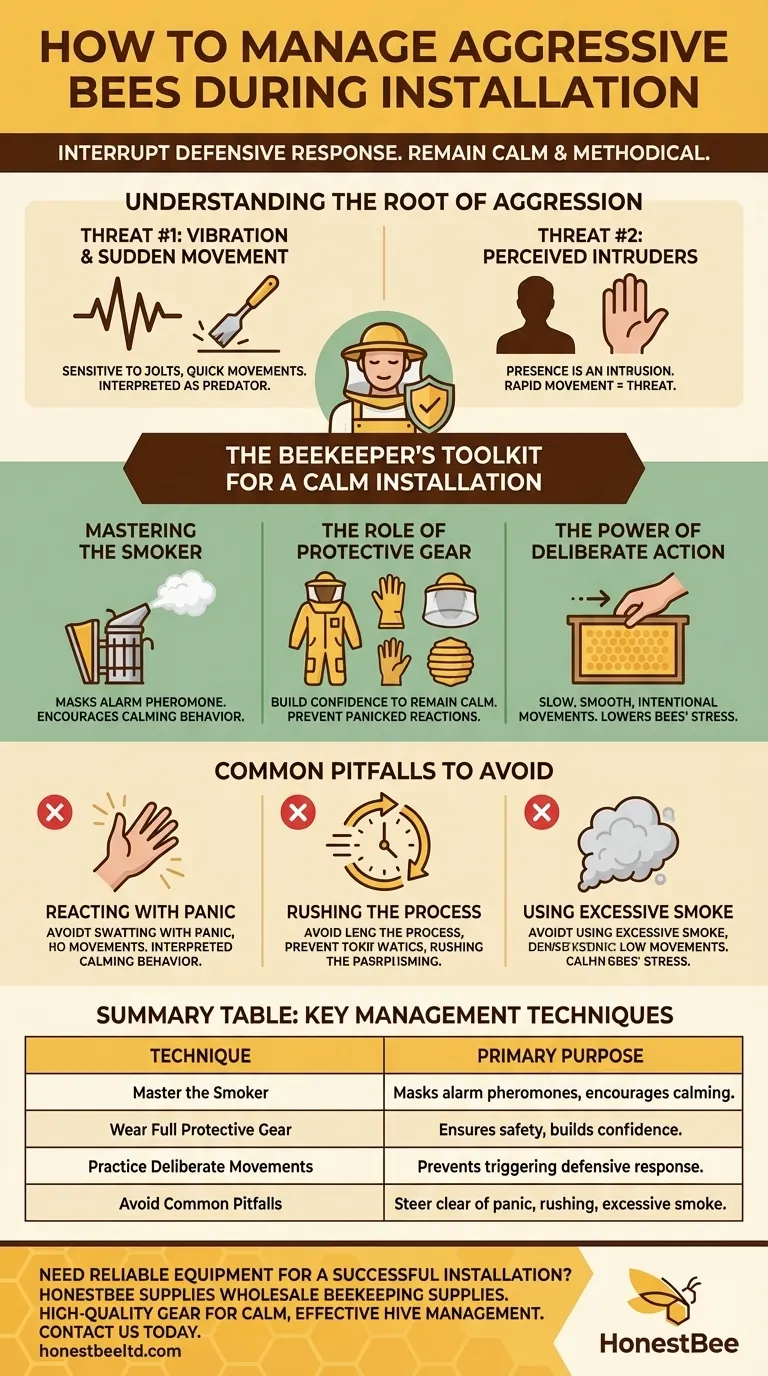To manage aggressive bees during installation, you must interrupt their defensive response using a smoker while ensuring your own safety with proper protective gear. The core of the technique is to remain calm and methodical, as slow, deliberate movements prevent the bees from perceiving you as a threat.
The central takeaway is that bee "aggression" during an installation is a predictable defensive reaction to stress and perceived threats. Your primary goal is not to fight the bees, but to control the environment and your own actions to signal safety and calm.

Understanding the Root of Aggression
Bees are not malicious; their aggression is a defensive instinct honed over millions of years. During an installation, you are creating a perfect storm of stressors that can trigger this response. Understanding these triggers is the first step to managing them.
Threat #1: Vibration and Sudden Movement
Bees are highly sensitive to vibration. A sudden jolt, a dropped tool, or even quick, jerky movements can be interpreted as a large predator—like a bear—trying to break into the hive. This is an immediate trigger for a defensive swarm.
Threat #2: Perceived Intruders
Your presence is an intrusion into their space. Rapid movements and loud noises confirm their suspicion that you are a threat that needs to be driven away. A calm, slow approach signals non-aggression.
The Beekeeper's Toolkit for a Calm Installation
Your tools and techniques are designed to mitigate the threats the bees perceive, allowing you to work safely and effectively.
Mastering the Smoker
The smoker is your most important tool for communication. A few gentle puffs of cool, white smoke at the entrance and over the top of the bees does two things: it masks their alarm pheromone, preventing a panic signal from spreading, and it encourages them to gorge on honey, which has a naturally calming effect.
The Role of Protective Gear
A full bee suit, gloves, and a veil are non-negotiable. Their primary purpose is not just to prevent stings, but to give you the confidence to remain calm. If you are not worried about being stung, you are far less likely to make the sudden, panicked movements that trigger the bees in the first place.
The Power of Deliberate Action
Every movement should be slow, smooth, and intentional. Think of it as a form of meditation or tai chi. When you handle frames or the bee package, do so with a gentle and deliberate hand. This methodical approach is the single most effective way to keep the bees' stress levels down.
Common Pitfalls to Avoid
Even with the right tools, simple mistakes can escalate the situation. Being aware of these common pitfalls is crucial for a successful installation.
Reacting with Panic
If a bee buzzes your veil or you get a sting, the natural human reaction is to swat or flinch. You must fight this instinct. A sudden reaction will only confirm to the other bees that you are a threat, inviting more defensive behavior.
Rushing the Process
Feeling anxious or being in a hurry is the enemy of a calm installation. Haste leads to mistakes, jarring movements, and dropped equipment. Give yourself plenty of time so you can work at a pace the bees are comfortable with.
Using Excessive Smoke
While a smoker is essential, over-smoking can be counterproductive. Too much smoke can irritate the bees or drive them from the hive. The goal is a few gentle puffs of cool smoke, not a dense cloud.
Making the Right Choice for Your Goal
Your approach should be guided by the immediate situation and your own comfort level.
- If your primary focus is personal safety: Fully commit to your protective gear. Ensure your suit is zipped, your veil is secure, and your gloves are on before you even approach the bees.
- If your primary focus is keeping the bees calm: Prioritize the smoker and your own movements. Use gentle puffs of smoke before the bees become agitated and move with slow, predictable grace.
- If you need a simple mantra to remember: Remind yourself that "slow is smooth, and smooth is fast." Deliberate, calm actions will get the job done more efficiently and safely than a rushed, frantic effort.
Ultimately, you are the leader in this interaction, and your calm confidence is the most powerful tool you have to ensure a successful installation.
Summary Table:
| Key Management Technique | Primary Purpose |
|---|---|
| Master the Smoker | Masks alarm pheromones and encourages calming behavior. |
| Wear Full Protective Gear | Ensures your safety and builds confidence to remain calm. |
| Practice Deliberate Movements | Prevents triggering the bees' defensive response. |
| Avoid Common Pitfalls | Steer clear of panic, rushing, and excessive smoke. |
Need reliable equipment for a successful installation? HONESTBEE supplies commercial apiaries and beekeeping equipment distributors with high-quality, wholesale-focused beekeeping supplies and equipment. Our gear is designed to give you the confidence and protection needed for calm, effective hive management. Contact us today to discuss your wholesale needs and ensure your next installation is a success.
Visual Guide

Related Products
- Stainless Steel Honey Bee Smoker Hive and Honeycomb Smoker for Beekeeping
- Economy Galvanized Beekeeping Honey Bee Smoker for Wholesale
- European Stainless Steel Bee Smoker for Honey Bee Hive
- Premium Traditional Copper Bee Smoker with Bellows
- Professional Bee Smoker with Elongated Spout and Durable Bellows for Beekeeping
People Also Ask
- How did early beekeepers use bee smokers? Master Ancient Bee Calming Techniques
- What happens to bees when they sense smoke? Unlock the Secret to Calm Hive Inspections
- What is the proper technique for lighting a bee smoker? Master the Layered Fire Method for Calm Hives
- What is the primary purpose of using smoke in beekeeping? Calm Bees for Safer Hive Management
- What is a bee smoker and what is its primary purpose? Master Safe Hive Inspections



















